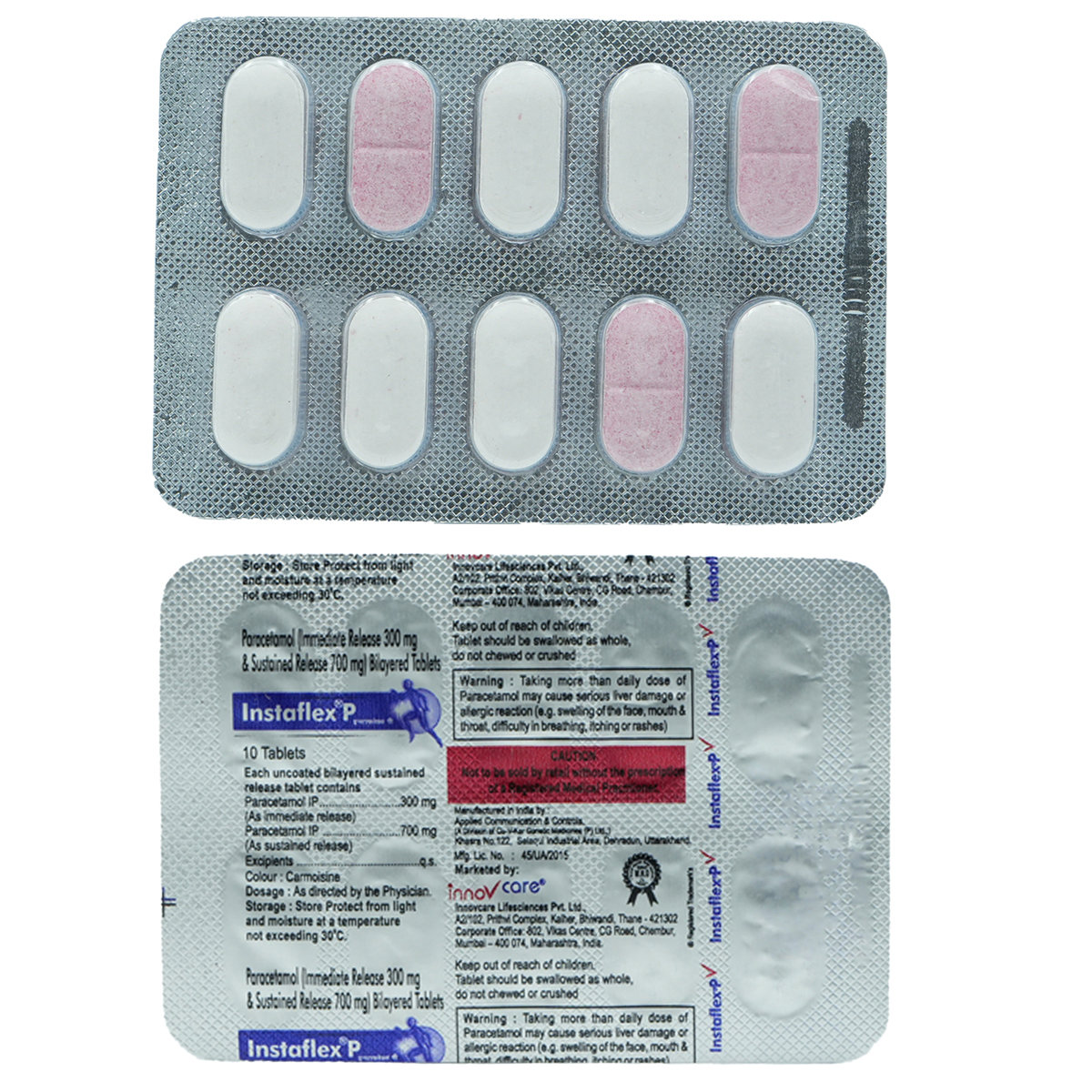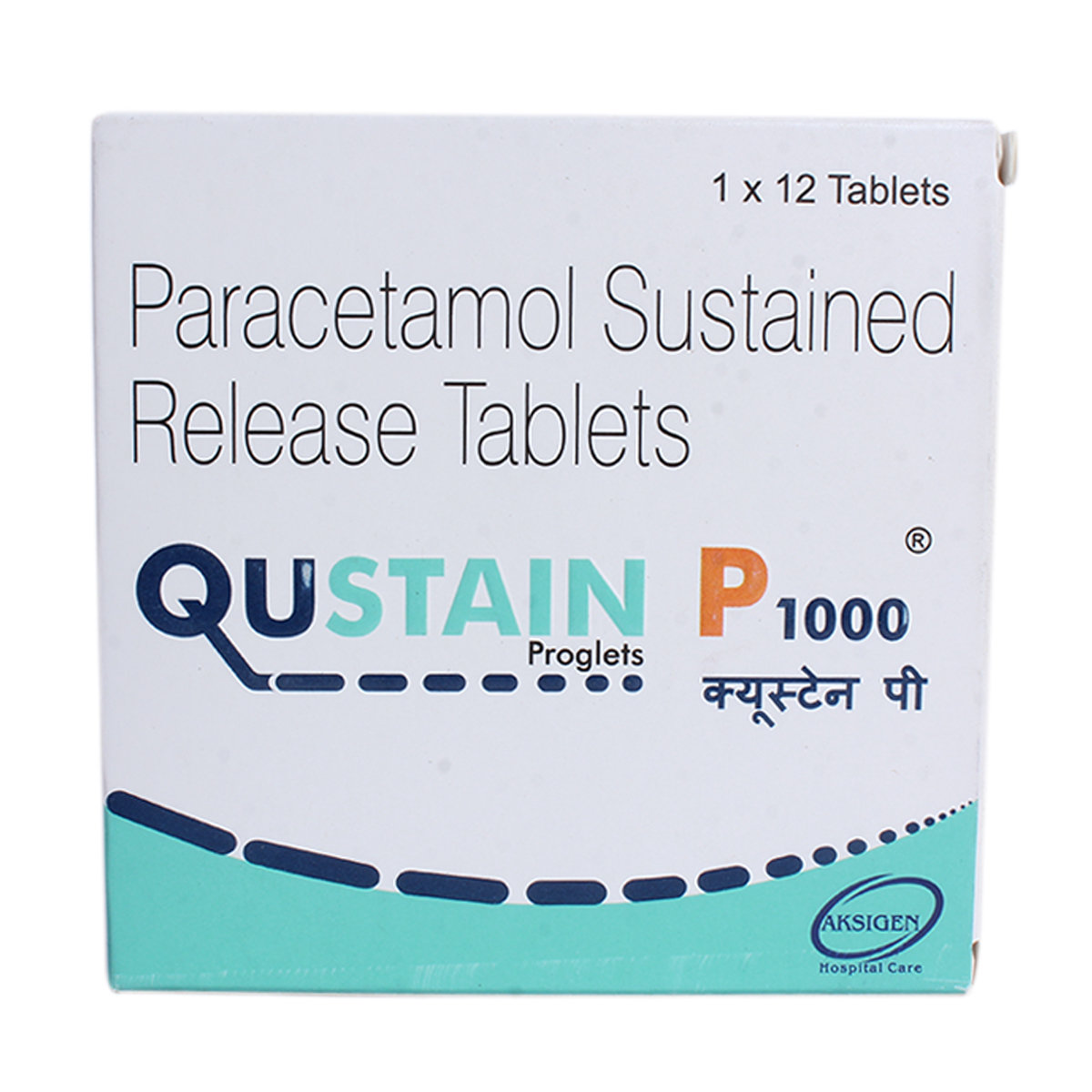Paracetamol
About Paracetamol
Paracetamol is used to reduce fever and treat mild to moderate pain. It is also used to relieve headaches, migraine, toothaches, period pain, back pain, muscle pain, and rheumatic pain. The activation of pain receptors causes pain and fever due to the release of certain natural chemicals in the body, like prostaglandin.
Paracetamol works by inhibiting the production of certain chemical messengers in the brain known as prostaglandins, reducing pain. Additionally, Paracetamol affects an area of the brain that regulates body temperature, known as the hypothalamic heat-regulating centre, which reduces fever.
Not everyone who is taking Paracetamol will get these side effects. In some cases, Paracetamol may cause side effects such as nausea, stomach pain and dark-coloured urine. Most of these side effects of Paracetamol do not require medical attention and gradually resolve over time. However, if the side effects persist or worsen, please consult your doctor.
Take Paracetamol as advised by your physician. Your doctor will recommend how often you should take Paracetamol, based on your medical condition. You can take Paracetamol with or without food. It is recommended not to exceed the recommended dose of Paracetamol. Do not chew, crush, or break the medicine.
Avoid taking Paracetamol if allergic to it. If you are pregnant or breastfeeding, please consult a physician before using Paracetamol. Avoid alcohol consumption with Paracetamol as it may increase the risk of liver damage. Let your doctor know if you have an impaired nutritional state caused by anorexia (eating disorder), malnutrition or alcohol abuse or if you are dehydrated before taking Paracetamol.
Uses of Paracetamol
• Pain Relief: Paracetamol is commonly used to treat mild to moderate pain, including headaches, toothaches, muscle aches, and menstrual cramps. It works by suppressing the brain's production of prostaglandins, which induce pain.
• Fever Reduction: Paracetamol effectively reduces fever caused by infections or other conditions. It lowers the body's temperature by working on the hypothalamic heat-regulating area.
• Cold and Flu Symptom Relief: Paracetamol is also used to treat cold and flu symptoms such as body pains, fever, and headaches.
• Post-Surgery Pain Management: Paracetamol is used to treat post-surgery pain, especially when it is mild to moderate, as an alternative to heavier pain drugs.
• Arthritis-related Pain: Paracetamol is used to treat joint pain and discomfort caused by osteoarthritis and rheumatoid arthritis, reducing pain and inflammation.
Medicinal Benefits
- Paracetamol contains Paracetamol, an analgesic (pain killer) and antipyretic (reduces fever).
- Paracetamol affects an area of the brain that regulates body temperature known as the hypothalamic heat-regulating centre, reducing fever.
- It is one of the most used OTC medicine for reducing pain and fever.
Directions for Use
- Paracetamol can be taken with or without food anytime.
- It is usually taken every 4-6 hours or as suggested by your doctor.
- Swallow Paracetamol as a whole with a glass of water.
- Do not crush, break, or chew it.
Storage
Side Effects of Paracetamol
- Nausea
- Stomach pain
- Dark coloured urine
Drug Warnings
- Avoid taking Paracetamol if allergic to it.
- Paracetamol is not recommended for children below 6 years of age as the safety and efficacy are not established.
- If you are pregnant or breastfeeding, please consult a physician before using Paracetamol.
- Avoid alcohol consumption with Paracetamol as it may increase the risk of liver damage.
- If you have an impaired nutritional state caused by anorexia (eating disorder), wrong nutrition or alcohol abuse or if you are dehydrated, inform your doctor before taking Paracetamol.
- Avoid taking more than the recommended doses, as it may increase the risk of serious liver damage.
- If you have a high fever or signs of infection after using Paracetamol for more than 3 days or if pain persists after using Paracetamol for more than 5 days, please consult a physician.
Drug Interactions
Drug-Drug Interactions: Inform the doctor if you are taking blood thinners (warfarin), cholesterol-lowering drugs (cholestyramine), analgesics (aspirin), antibiotics (chloramphenicol, rifampicin), anti-gout medicines (probenecid), antitubercular drug (isoniazid), anticonvulsants (lamotrigine, carbamazepine, phenytoin), and anti-nausea agents (metoclopramide, domperidone).
Drug-Food Interactions: No interactions found.
Drug-Disease Interactions: If you have kidney or liver disease, hepatitis, Gilbert's syndrome (a liver condition), hemolytic anaemia (abnormal breakdown of red blood cells), G-6-PD deficiency (a hereditary condition resulting in low red blood cell counts), blood poisoning, inform your physician before taking Paracetamol.
Drug-Drug Interactions Checker List:
Safety Advice

Alcohol
unsafeYou are recommended to avoid consumption of alcohol with Paracetamol as it may cause severe liver damage.

Pregnancy
consult your doctorPlease consult a physician if you are pregnant or planning for pregnancy before using this medicine. Your physician may suggest the lowest dose of Paracetamol for the shortest duration if you are pregnant.

Breast Feeding
consult your doctorParacetamol may be excreted in small amounts in breast milk. Therefore, please consult a physician before using this medicine if you are breastfeeding.

Driving
safe if suggestedParacetamol usually does not affect your ability to drive or operate machinery.

Liver
cautionTake Paracetamol with caution, especially if you have a history of liver disease. Your physician may adjust the dose as required.

Kidney
cautionTake Paracetamol with caution, especially if you have a history of kidney disease. Your physician may adjust the dose as needed.

Children
consult your doctorPlease consult a doctor. Your doctor will prescribe a suitable dose of Paracetamol based on the age, body weight and condition of your child.
Habit Forming
Diet & Lifestyle Advise
- Get adequate sleep, as resting the muscles can help in reducing inflammation and swelling.
- Follow heat or cold therapy, and regularly apply a cold or hot compress on the joints for 15-20 minutes.
- Acupuncture, massage and physical therapy may also be helpful.
- Eat foods rich in antioxidants such as berries, spinach, kidney beans, dark chocolate, etc.
- Foods containing flavonoids, such as soy, berries, broccoli, grapes, and green tea, help reduce inflammation.
- Maintain a healthy weight by performing regular low-strain exercises and eating healthy food.
- Avoid smoking and alcohol consumption.
Patients Concern
Disease/Condition Glossary
Pain: It is a term used to describe any unpleasant feeling or discomfort. It occurs due to nerve damage (in cases of backache, toothache, or muscle pain) or persistent stimulation (in headaches or migraine). Pain may vary from mild to severe, depending on the underlying condition.
Fever: It is an abnormal increase in body temperature due to infection, chemotherapy, or various disease conditions. If the body temperature is 98.6°F, it is normal, and if it goes above 100.4°F (38℃), it is called a fever or pyrexia. Body temperature is increased in response to infection or varied problems to protect the body. The flu is one of the most common causes of fever.
FAQs
Paracetamol is used to provide relief from fever and mild-to-moderate pain.
Paracetamol works by inhibiting the production of certain chemical messengers in the brain known as prostaglandins. Thus reducing pain. Also, Paracetamol affects an area of the brain that regulates body temperature known as the hypothalamic heat-regulating centre. Thus, it reduces fever.
You are not recommended to take Paracetamol with warfarin as co-administration of these two medicines may increase the risk of bleeding more easily. However, if you are supposed to use these medicines together, you are advised to contact your physician so that the dose may be adjusted appropriately and used safely.
Paracetamol may affect how certain tests work, such as blood sugar tests and uric acid tests. Therefore, if you are about to undergo a blood test or any laboratory tests, inform your physician or lab technician that you are taking Paracetamol.
You are not recommended to take Paracetamol with other paracetamol-containing products as it may cause paracetamol overdose.
If you take more than the suggested dose of Paracetamol, it may cause an overdose and lead to serious liver damage. The symptoms of overdose include vomiting, loss of appetite, stomach pain, paleness and nausea. However, if you have overdosed or experience any of these symptoms, please consult a doctor immediately.
Paracetamol can be administered up to 4-6 times a day, ensuring a minimum gap of four hours between each dose. Avoid using Paracetamol for more than three consecutive days without medical advice, as excessive use may harm the liver.
You can take Paracetamol with or without a meal. However, if it causes stomach problems, it is best to take it after eating. Taking it with food may minimize the likelihood of nausea or discomfort in some people.
Paracetamol is generally considered safe during pregnancy and breastfeeding when taken in the recommended amounts. However, it should only be used when necessary and with your doctor’s approval to avoid any risks.
You should consult your doctor before taking Paracetamol with other medications. Some medications may interact with Paracetamol, affecting its effectiveness or increasing the risk of side effects. Always check for possible interactions, especially if you are using other suggested or over-the-counter medications.
You should not use Paracetamol for long-term pain management without consulting your doctor. While it is effective for short-term pain relief, using it for extended periods may raise the risk of side effects, especially liver damage.
No, Paracetamol is not an antibiotic. It is usually used to treat pain and fever. Antibiotics are used to treat bacterial infections, while Paracetamol does not have any effect on bacteria.
You can normally drive or ride a bike after taking Paracetamol because it rarely causes drowsiness or impairs your ability to focus. However, if you feel dizzy, drowsy, or uncomfortable, you should avoid driving or riding until you feel better.
Paracetamol is usually not recommended to be taken with alcohol. Alcohol can raise the chance of adverse effects, such as liver damage, particularly when combined with drugs like paracetamol. Consult your doctor for advice based on your health condition.
You can usually take Paracetamol with an antibiotic. Paracetamol helps with pain or fever, and the antibiotic treats the infection. Check with your doctor if you are taking any other medications or have any health problems.
Your doctor will prescribe the appropriate dose of Paracetamol for your child based on their age, weight, and condition. Please consult a doctor for guidance.
Paracetamol usually starts working within 30-60 minutes and can provide full relief within an hour. However, this might differ depending on your condition and how your body reacts.
You can take Paracetamol and ibuprofen together for short-term pain relief if advised by the doctor, as they work differently. Make sure to take them at different times to avoid side effects. It's best to use this combination for a short period and ask your doctor if you're unsure or have other health conditions.
Yes, Paracetamol can cause nausea and vomiting in some people, although these side effects are not very common. If you experience persistent nausea or vomiting, consult your doctor for advice.
Paracetamol is not usually used to treat stomach pain from indigestion. It mainly helps with pain relief or reducing fever. Always consult a healthcare provider for the proper treatment.
Taking too much of Paracetamol can be dangerous and may lead to serious side effects, especially liver damage. Common signs of overdose include nausea, vomiting, stomach pain, loss of appetite, yellowing of the skin or eyes, sweating, and extreme tiredness or confusion. If you take more than the recommended dose of Paracetamol, get medical help immediately, even if no symptoms appear.





